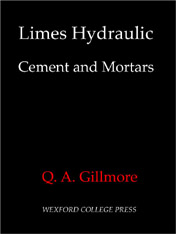



Limes Hydraulic Cements, and Mortars

II. Precautions employed in procuring cements for testing. Appliances for testing the transverse strength, hardness, and adhesive properties of mortars.
III. Rosendale cement. Location and capacity of the manufactories. Cement works at Sheperdstown, Va. The Round Top cement works near Hancock, Md. The Cumberland cement works. The James River cement works. The works at Utica, La Salle Co., Il. Sandusky, Ohio, Louisville, Ky. Kensington, Conn., and Akron, Manlius, and Chittenango, N.Y. The Portand and the Roman cements.
IV. Common lime, and lime mortars. Hydraulic limes and cements. Natural pozzuolana and trass. Arenes. Artificial hydraulic cement and lime. The use of alkaline and bétona in sea water. Opinions theron of Marshal Vallant, Inspector-General Noel, MM. Ravier, Féburier, Vicat, and other French authorities.
V. Diversified character of limestone beds. Method of testing the stone experimentally. Qualitative and quantitative analysis. Analysis of various cements, limes, trass and pozzuolana. Kilns for burning cement and method of burning. Effect of varying the intensity and duration of the heat. Preservation and restoration of cements.
VI. Mortar defined. Aggregates. The use of sand. Method of slaking lime. Action of hydrates in air and under water. Mill-made mortar. Hand-made mortar. Composition and cost of mortar used in Forts Richmond, Tompkins, and Warren. Pointing mortar. Interior and exterior plastering.
VII. Concrete or béton. How made and used. How laid under water. Composition and cost of concrete used at Forts, Richmond, Tompkins, and Warren. Use of concrete at Toulon, Algiers, Marseilles, Cherbourg, Dover, Alderney, etc. Tables giving strength of various kinds of concrete.
VIII. Neat cement made semi-fluid with excess of water. Superiority of Portland over the natural quick cements, when so employed. Comparison of Portland and Roman cements. Adhesive properties of American cements. Transverse strength of various mortars.
IX. Mural efflorescences. Induration of mortars of fat lime. Theory of hydraulic induration. The hardening by artificial means of stone, brick, mortar, etc.
Appendix: Description and cost of several kinds and qualities of concrete used in the construction of the fortifications on Staten Island, New York Harbor.